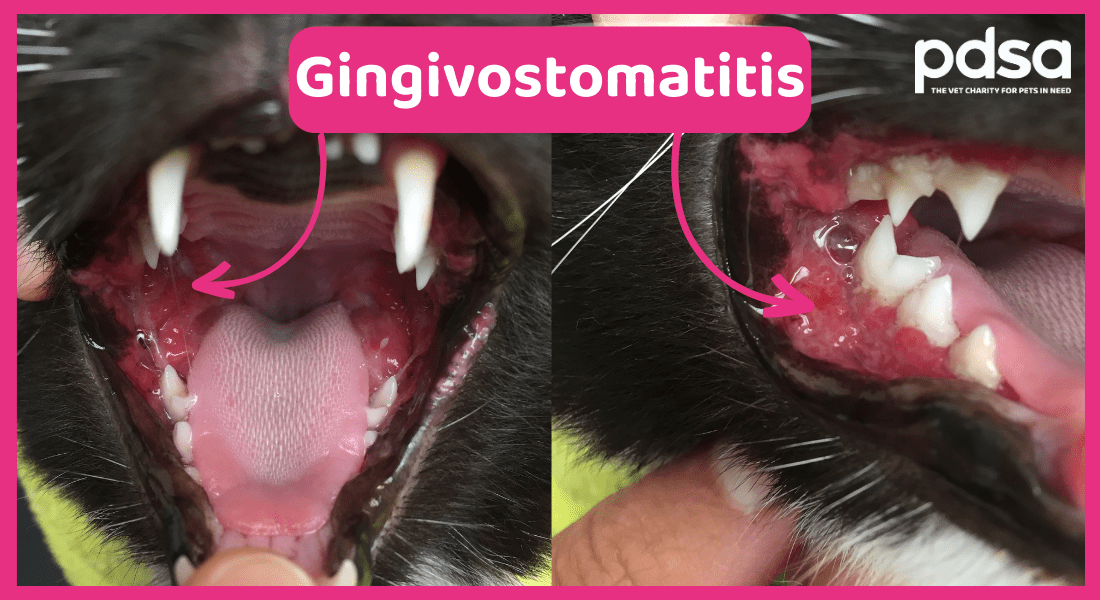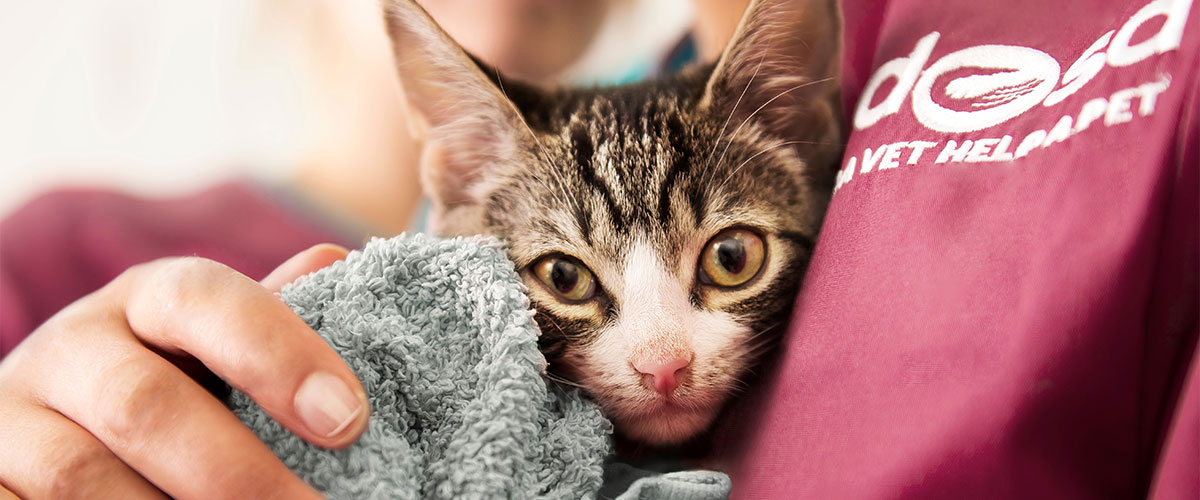Dental Disease in Cats
Overview
- Dental disease is common in cats, especially as they get older.
- It’s important to check your cat’s teeth and gums regularly because most cats try their best to hide pain, so often don’t show symptoms of dental disease until it’s very severe.
- It’s also important to have any dental problems treated promptly because, left untreated, they can lead to other issues such as kidney disease and heart disease.
- Fortunately, there are plenty of things you can do to keep your cat’s mouth healthy throughout their life.
Why does my cat have dental disease?
There are several things that make dental problems in cats more likely including old age, infectious disease, and misaligned teeth.
Age – as your cat gets older, they are more likely to develop dental disease due to wear and tear of their teeth throughout life.
Infectious disease – certain feline diseases, such as Cat Flu, Feline Leukaemia Virus (FeLV) and Feline Immunodeficiency Virus (FIV) can cause gingivitis and gingivostomatitis in cats, and make other types of dental disease more likely.
Misaligned teeth – cats with teeth that don’t sit neatly aligned in the mouth are much more likely to accumulate plaque and tartar, and develop dental disease. This is common in cats with:
- Retained baby teeth – because their mouth becomes overcrowded.
- Pedigree cats with short noses (such as Persians) - because they have small, overcrowded mouths.
- Abnormally shaped jaws – such as cats who have broken their jaw, or were born with an over bite/under bite.
Symptoms of dental disease in cats
- Bad breath
- Mouth pain
- Reduced appetite
- Weight loss
- Difficulty eating (chewing on one side/preferring soft food)
- Drooling
- Visible tartar
- Red, sore, bleeding gums
- Wobbly teeth
- Swelling around the face, jaw, or cheeks
- Grooming less (due to having a painful mouth)
Plaque and tartar build up
Plaque is a soft mix of saliva, food, and bacteria that builds up on teeth throughout the day. If plaque isn’t removed regularly, it will turn into a hard substance called tartar. Tartar subsequently causes gingivitis (inflammation of the gums) and is full of bacteria that can enter the bloodstream and cause problems such as kidney disease and heart disease.

Feline resorptive lesions
Feline resorptive lesions (FORLs) are holes in the teeth that develop just along the gum line. They cause the teeth to become weak and snap off at the gum line, leaving just the root behind – which is very painful. If your cat has teeth with FORLs, it’s likely that your vet will recommend removing them under anaesthetic. FORLs are an extremely common problem that affects more than a third of pet cats at some point throughout their life.
Tooth root abscesses
A tooth root abscess is a painful infection around a tooth root (see image). Tooth root abscesses tend to form if there is something else wrong with a tooth which means bacteria can get under the gum. Tooth root abscesses usually cause swelling on one side of the face, just under the eye. Treatment usually involves antibiotics and, in severe cases, tooth removal.

Treatment
Treatment for dental disease depends on the problem at hand, but typically includes some of the following:
- Anti-inflammatory pain relief – to keep your cat comfortable.
- Antibiotics – to fight infection (not always necessary).
- Scale and polish – if your vet spots plaque and tartar build-up, they may recommend a ‘scale and polish’ to prevent further problems developing – similar to a professional clean you would get from your own dentist (but needs to be done under anaesthetic).
- Tooth removal – if your cat has severe dental disease they may need teeth removed. This is to stop pain, prevent the jaw bones from becoming infected and to help stop other teeth from rotting. Fortunately, cats adapt incredibly well to having teeth removed.

To keep your cat’s mouth as healthy as possible, you'll need to give them a bit of help with their dental hygiene.
- Tooth brushing: If your cat will allow it, brushing their teeth is by far the best way to keep their mouth healthy because it removes plaque before it turns into tartar. It's easier if your cat gets used to having their teeth brushed as a kitten, but older cats can learn too. Follow these simple steps:
- Get some cat-safe toothpaste (not human toothpaste) and a cat toothbrush or microfiber finger cloth for tooth cleaning.
- Give your cat a little of the toothpaste on your finger around the same time every day. This will get them used to the routine, taste, and smell. If they won't take it from your finger, offer it to them in their food bowl, or put a small spot of it on their front leg so they lick it off – then work up to feeding it on your finger.
- Get them used to having their lips lifted, starting by gently touching the side of their mouth (avoiding their whiskers), and gradually build up to lifting their lips – give them lots of treats before and afterwards, so they think of it as a positive experience.
- Once they are comfortable with having their lips lifted, start gently touching their teeth and gums, rewarding them with lots of treats.
- When they are happy with that, you can start to introduce a little toothpaste on your finger.
- Next, use the toothbrush, making small, circular motions on the outer surfaces of the teeth. Always brush gently and not directly on their gums.
- If your cat shows signs of pain, or their gums look sore or bleed when you are brushing, stop the process and speak to your vet for further advice.
- Cat mouthwash: Special pet-friendly mouthwash added to your cat’s drinking water may help reduce the build-up of plaque. Never use human mouthwash for your pets.
- Dental gel: Dental gels contain enzymes and mild abrasives that can help to prevent the build-up of plaque. It can be applied by rubbing it directly onto the teeth and gums but, if this isn’t possible, you can try to encourage your cat to lick it off your finger/their own paw. Dental gels aren’t as effective as brushing your cat’s teeth but are a good alternative if your cat won’t tolerate anything else.
- Diet: Feeding your cat the right diet can really help keep their mouth healthy. If possible, try to feed your cat a mix of wet food and biscuits, as the chewing required to eat biscuits helps to remove some of the plaque that builds up on their teeth throughout the day. Try to keep sugary human foods and treats to a minimum. If your cat is prone to dental problems, your vet can recommend a special dental diet designed to stop the build-up of plaque.
- Check-ups: Regular dental check-ups with your vet will help prevent problems from becoming serious. A good time for a dental check-up is at their yearly booster vaccination.
- Dental treats: You can buy dental treats for cats designed to help keep their teeth clean. These are fine as an occasional treat, but you shouldn’t rely on them for your cat’s dental health.
When to contact your vet
Book an appointment with your vet if you think your cat might have dental disease. Your vet will be able to examine inside his/her mouth, which we know can be tricky at home! Contact your vet for an urgent appointment if your cat has broken a tooth, is unable to close his/her mouth, or has stopped eating.
Cost
Dental disease can cost several hundred pounds (this varies a lot depending on the problem). Always speak to your vet if you can’t afford the treatment they have recommended because there may be another option.
Consider taking out cat insurance as soon as you bring your cat home, before any signs of illness start. This will give you peace of mind that you have some financial support if they ever become unwell.
Published: February 2023
Did you find this page useful?
Tell us more
Please note, our vets and nurses are unable to respond to questions via this form. If you are concerned about your pet’s health, please contact your vet directly.
Thank you for your feedback
Want to hear more about PDSA and get pet care tips from our vet experts?
Sign up to our e-newsletter
Written by vets and vet nurses. This advice is for UK pets only. Illustrations by Samantha Elmhurst.

 Video found at youtu.be/mJGG_eBj7iI
Video found at youtu.be/mJGG_eBj7iI




